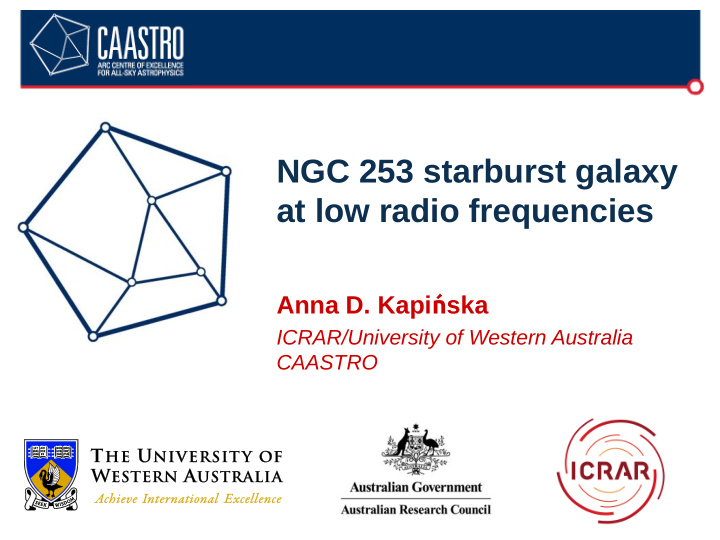



NGC 253 starburst galaxy at low radio frequencies Anna D. Kapi ń ska ICRAR/University of Western Australia CAASTRO
Introduction: NGC 253 – the Sculptor galaxy Archetypal nuclear starburst galaxy. Located in the nearby Sculptor Group at a distance ~3.9 Mpc, cz = 240 km/s ESO (R,V,H α ,OIII)
Introduction: NGC 253 – the Sculptor galaxy Archetypal nuclear starburst galaxy. Located in the nearby Sculptor Group ➢ stellar mass 4 x 10 10 M ⊙ at a distance ~3.9 Mpc, cz = 240 km/s ➢ stellar halo of 2.5 x 10 9 M ⊙ ➢ star formation rate ~5 M ⊙ /yr (Bailin+2011; Lucero+2015) ESO (R,V,H α ,OIII) G.Meurer (H α )
GaLactic and Extragalactic All-sky MWA Survey – GLEAM Murchison Radio Observatory Western Australia ➢ 72 – 230 MHz (20 bands) ➢ sky south of declination +30 ° Kapinska ➢ depth: ~10 mJy/beam @200MHz ➢ resolution: ~2 arcmin @200MHz GLEAM: Wayth+ 2015 Data Release 1 (DR1): Hurley-Walker+ 2017 Hurley-Walker
Talk outline ➢ Synchroton radio halo ➢ Broadband radio spectral energy distribution (SED) ➢ Spectral index map ( α ) & multi-frequency context
NGC 253 – low frequency radio GLEAM MWA/EoR0 Offringa+2016, MWA/EoR collab. GLEAM H α + GLEAM 200 MHz contours
Synchrotron radio halo 78.5 ° Projected scale-height (maximum vertical extent)
Spectral energy distribution – radio Kapinska et al. ApJ under review Total flux density Central starburst (300-500 pc)
Spectral energy distribution – radio Kapinska et al. ApJ under review GLEAM EoR Total flux density TGSS Central starburst (300-500 pc)
Spectral energy distribution – radio Kapinska et al. ApJ under review Disk & halo Central starburst
Radio emission – models synchrotron emission free-free emission absorption at low frequencies optically thick regime self-absorption
Radio emission – models synchrotron emission free-free emission absorption at low frequencies optically thick regime Internal or external free-free absorption of synchrotron emission self-absorption galaxy Line of sight H II galaxy external internal
Spectral energy distribution – radio Kapinska et al. ApJ under review Disk & halo curved synchrotron emission cf. Carilli 1996 Central starburst – internal f ree-free absorbed synchrotron emission, turnover: ~230 MHz
Radio spectral index map Kapinska et al. ApJ under review α 200 MHz – 1.46 GHz
Multiwavelength view Kapinska et al. ApJ under review Soft X-ray (<1 keV; Bauer+2008) Extraplanar HI (KAT-7; Lucero+2015) Spectral index (0.2–1.46 GHz)
Multiwavelength view Kapinska et al. ApJ under review Soft X-ray (<1 keV; Bauer+2008) Extraplanar HI (KAT-7; Lucero+2015) Spectral index (0.2–1.46 GHz) Spectral flattening * e – low-frequency cut off? * strong superwind collimating cold gas? → extraplanar HI
Summary ● New, deep low-frequency radio images of NGC 253 → amazing capabilities of MWA – SKA precursor! ● Radio emission at MHz frequencies a combination of central starburst ( internally free-free absorbed synchrotron ) and extended emission of disk and halo ( synchrotron flattening at low radio frequencies ) ● Spectral turnover of central starburst for the first time statistically constrained, at ~230 MHz ● Extensive synchrotron radio halo of NGC 253 imaged by MWA, extending up to 8 kpc at 200 MHz
Recommend
More recommend